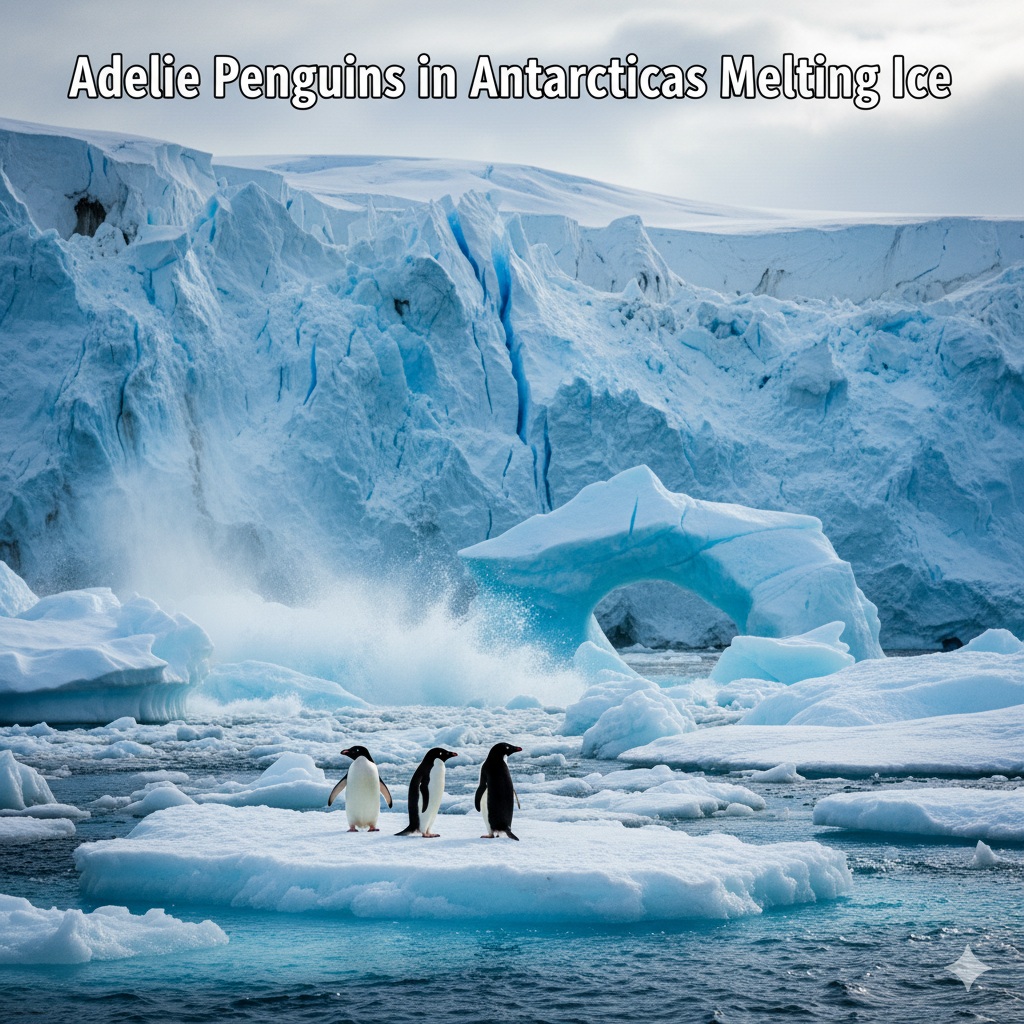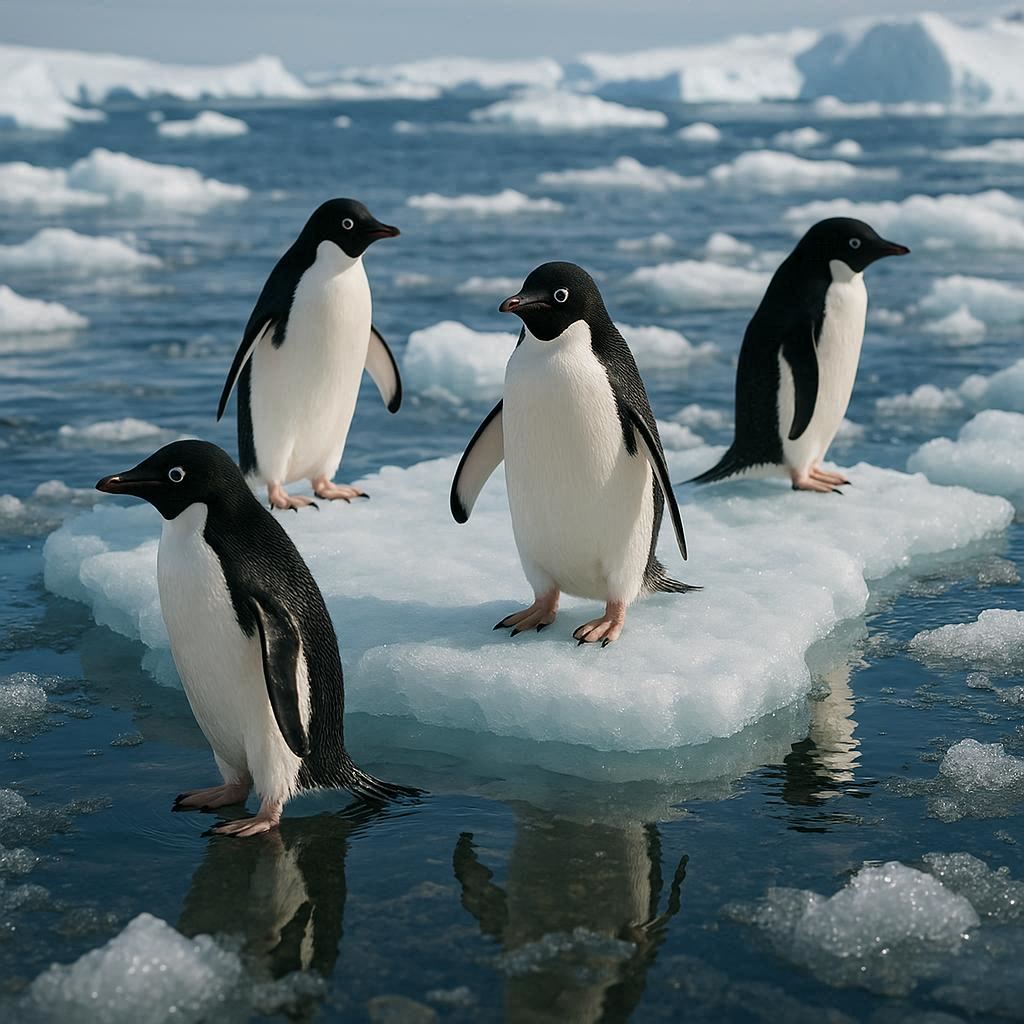
Adélie Penguins are small, black-and-white seabirds living on the icy continent of Antarctica. They are famous for their large, noisy colonies, where thousands gather to breed and raise their chicks. But as Antarctica loses more of its ice, scientists are closely watching how these penguins are doing and what the future holds for them.
How Many Adélie Penguins Are There?
The latest studies estimate there are over 3.79 million breeding pairs of Adélie Penguins in Antarctica—more than twice the population previously thought. That means there may be more penguins in Antarctica than people in Greece! These birds nest in large groups, ranging from just a few dozen pairs to colonies with more than 250,000 pairs.
- In the Ross Sea region, the population is at its highest in 30 years, with about a million breeding pairs—making up almost 38% of all Adélies in Antarctica.
- Scientists found 251 different colonies, including some new ones that may have recently formed. But some older colonies disappeared, especially where the sea ice has vanished.
Why Do Penguins Need Sea Ice?
Adélie Penguins rely on sea ice for almost everything:
- They hunt for food in the waters under and near the ice, mostly eating krill and small fish.
- Penguins nest on land that’s swept clear of snow, but they need to be close to sea ice for easy access to food during breeding season.
Too much or too little ice can be a problem. Not enough ice, and the penguins might have to travel far for food, putting their chicks at risk. Too much ice, especially in summer, can make it hard for adults to reach food, and hungry chicks may not survive.

Melting Ice: A Mixed Bag for Penguins
Antarctica’s climate is changing fast. In some places, the ice shelves—giant sheets of ice attached to the land—are melting and collapsing. This changes where penguins can live and breed.
- On the tip of the Antarctic Peninsula (the part closest to South America), Adélie colonies have shrunk dramatically. Loss of sea ice means penguins there have a much harder time surviving.
- But in East Antarctica and the Ross Sea, melting glaciers and changing winds have created more open water and good breeding grounds, letting some colonies grow rapidly. Wind patterns and even big holes in the ozone layer have helped form more shore ice in these regions.
Adelie Penguins and Melting Ice in Antarctica
The impact of melting ice on Adelie penguin [Finally Solved] populations in Antarctica is complex and varies significantly by region, often creating a “climate change winner” and “loser” scenario across the continent.
Negative Impacts (Especially in the Antarctic Peninsula)
In areas that are rapidly warming, particularly the Western Antarctic Peninsula, the melting of sea ice and changing weather patterns pose significant threats:
- Food Shortage (Krill Decline): Antarctic krill, a primary food source for Adelie penguins, rely on sea ice to shelter and feed on the algae (epontic species) that grow on its underside. The decline of sea ice leads to a decrease in krill, which in turn causes food scarcity for the penguins.
- Reduced Foraging/Resting Habitat: Adelie penguins use sea ice as a platform for resting between foraging dives and as a safe place to molt their feathers, away from predators like leopard seals. Less ice reduces these vital platforms.
- Breeding Failures from Increased Snowfall: Warmer air holds more moisture, leading to increased snowfall in the Antarctic Peninsula. Adelie penguins nest on bare, snow-free ground and use pebbles to build their nests. Excessive snow can cover their nesting sites, leading to:
- Wet Eggs and Chicks: Eggs laid in the snow are less likely to hatch, and young chicks with non-waterproof feathers can get cold and perish in wet conditions.
- Delayed Nesting: Penguins have a strict breeding schedule and may not be able to wait for the snow to melt.
Due to these factors, Adelie penguin populations in the Western Antarctic Peninsula have seen a dramatic decline in recent decades, with some colonies vanishing entirely.
Positive/Stabilizing Impacts (Especially in East Antarctica/Ross Sea)
In parts of East Antarctica and the Ross Sea, the effects of changing ice conditions have been different, and some populations are stable or even increasing:
- Easier Foraging Access: For some mainland Antarctic colonies, too much consolidated sea ice can make the journey from the colony to the open water for foraging long and energetically costly. A moderate reduction in sea ice can actually improve foraging efficiency by allowing the penguins to swim directly into open water near the colony, saving time and energy.
- More Nesting Sites: As perennial ice and glaciers retreat, more ice-free coastal land becomes exposed, providing an increase in potential rocky, snow-free nesting habitat.
This regional variation means that while some Adelie populations are decreasing rapidly, others are thriving due to localized conditions. However, the long-term projection under continued global warming remains a major concern for the species overall.
Why Are Some Colonies Growing While Others Shrink?
Adélie Penguins have been able to thrive in places where changing conditions leave them more space and food. For example:
- After commercial fishing reduced numbers of whales, seals, and toothfish, there are fewer competitors for krill and silverfish, which Adélie Penguins eat. This gives penguins more available food.
- In areas with favorable winds, more ice forms near the shore, making it easy for penguin parents to come and go from their nests.
- Colonies in the Ross Sea have been especially lucky, showing steady 6% annual growth since 2001.
However, not every region is a success story. In East Antarctica, the Mawson colony lost 43% of its population over the last decade due to too much summer ice, making it very tough for parents to feed their chicks. When colonies get smaller, fledgling penguins become more vulnerable to predators like leopard seals.
A Snapshot: Counting Penguins by Satellite
Modern technology, like satellite images, helps scientists keep track of penguin populations. They can spot large stains of penguin guano (poop) on the rocks, which marks out colony size. Better technology means more accurate counts and helps spot trends in population changes from year to year.
- Field surveys, in addition to satellite imagery, help confirm if colonies are growing or shrinking.
- Scientists emphasize that these counts are “snapshots” and that populations can change quickly due to shifts in ice, food, or weather conditions.
The Food Web: How Penguin Success Links to Other Animals
The Southern Ocean, which surrounds Antarctica, is packed with life. Tiny plankton feed krill and fish, and those in turn feed penguins, seals, and whales. Melting ice helps fertilize the ocean by dumping iron-rich sediment, triggering huge plankton blooms.
- Commercial fishing and hunting have changed the balance, giving Adélies more access to food in recent decades.
- Still, in a single colony or region, a good year for penguins might be followed by a bad one, depending on conditions, food supply, and competition.
Melting Ice Shelves and Global Consequences
The Melting ice isn’t just a penguin problem. It raises sea levels worldwide and changes ecosystems in surprising ways. Scientists have learned that Antarctica’s melting is driven by climate warming and complex ocean processes. Sometimes, “wild card” effects like shifting wind patterns or ozone changes can make things better or worse in different areas.
- Big swings in ocean temperature, repeating roughly every 50 to 60 years, mean Antarctica doesn’t always react to global warming the same way everywhere.
- Interior Antarctica has actually gotten colder, while coastal regions see warming and more rapid ice loss.
The Ozone Hole: Do Penguins Care?
A “hole” in the ozone layer over Antarctica lets more heat escape into space, making the vortex of cold air around the Pole last longer. This can influence ice formation and temperatures, likely helping Adélie Penguins in some regions for now.
- The Montreal Protocol helped stop the production of ozone-destroying chemicals, and the ozone hole is slowly shrinking. Scientists expect the layer to recover by about 2050-2070, but no one knows just how this will impact penguins in the long run.
What Does the Future Hold for Adélie Penguins?
Adélie Penguins are considered “indicator species”—they show scientists how healthy the whole Antarctic marine ecosystem is. Because they depend so closely on sea ice and krill, changes in their populations warn us about bigger changes in the environment.
- For now, many Adélie colonies are stable or thriving, especially in colder regions like the Ross Sea.
- In other areas, shrinking sea ice spells trouble; populations could crash suddenly if warming continues and ice disappears.
Long-term monitoring is essential, and scientists use penguin data to help plan conservation efforts and manage fisheries so there will be enough krill and fish for the penguins to eat.
Conclusion: Resilient, But At Risk
Adélie Penguins show both the resilience and the vulnerability of wildlife in a changing world. They’ve survived dramatic climate changes before by moving or adapting, but the challenges they face today—from melting ice, changing food webs, and human activity—are bigger and happening faster.
- The fate of Adélie Penguins depends on sea ice, food availability, and changing climates.
- Protecting their environment, understanding changes, and making smart conservation decisions are crucial so that future generations can keep enjoying the bustling, lively colonies that make Antarctica special.
Citations and References
- https://www.pnas.org/doi/10.1073/pnas.2306840120
- https://www.antarctica.gov.au/news/2022/dramatic-decline-in-adelie-penguins-near-mawson/
- https://cse.umn.edu/college/news/new-study-finds-adelie-penguin-population-rise
- https://www.nature.com/articles/s43247-025-02345-7
- https://www.smithsonianmag.com/smart-news/adelie-penguins-are-dwindling-in-east-antarctica-180980941/
- https://oceanwide-expeditions.com/blog/adlie-penguins-in-the-ross-sea-antarctica
- https://pallter.marine.rutgers.edu/docs/publications/documents/lterfinalms/389lterc.pdf
- https://www.sciencedirect.com/science/article/abs/pii/S0277379123003566
- https://eos.org/articles/ice-loss-benefits-adlie-penguins-for-now

Hi, There and Welcome to BirdsNews.com, is here to help you learn and care about pet birds. and this blog is a journal of everything I’ve learned.
